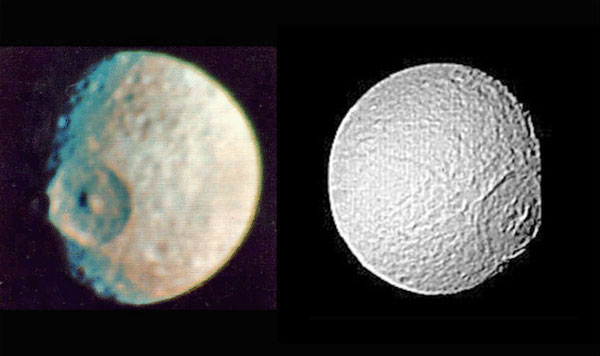|

from
Thuntherbolts Website
Sep 29, 2004

Credit: NASA, Voyager
I
esp_lunassistsolar07_image1
Mimas and
Tethys are two small moons orbiting Saturn.
Since their discoveries in 1789 and 1684 respectively until the
Voyager probes passed by them in 1980, we could see them only
through telescopes and then only as two moving dots of light.
Even
the Voyager images (above Mimas left,
Tethys right) are very tiny, taken from hundreds of
thousands of miles away.
Now Cassini could examine them close-up (although no direct
flybys of either moon are scheduled for the 4-year Cassini
mission.) Astronomers were surprised by the Voyager images
of immense craters and cliffs. Mimas is only
about 400 kilometers (250 miles) across, but the crater
Herschel is dug out of 130 of those kilometers (in
projection), covering 3% of Mimas' surface.
To
reach the surface from the floor of Herschel, you
would have to climb up 10 kilometers (6 miles) of steep cliffs -
more than climbing Everest from sea level. (If you
wanted a less strenuous climb, you could ascend Herschel's
central peak - at 6 kilometers, it would match an ascent of
Kilimanjaro.) Tethys is over 1000 kilometers
(600 miles) in diameter. Its large crater, Odysseus,
at 400 kilometers (250 miles) across, covers 4% of Tethys'
surface. The floor of the crater is convex and matches the curvature
of the surface. This means that in the middle of the crater, Odysseus' floor protrudes beyond the crater's rim.
Several astronomers expressed surprise that the impacts they assumed
caused the craters didn't shatter the tiny moons (this comment is
made about other moons and asteroids with
disproportionately large craters, too.) From the Electric
Universe viewpoint, shattering wasn't a possibility. The craters
were excised from the surfaces by an interplanetary-size
electric arc - a "thunderbolt." Instead of
exerting a shattering force into the moon, as an impact would do,
an arc would dissociate the surface material and lift the debris
into space along the current channel.
At the edges of the arc, the electric force would fall
off rapidly, resulting in the steep sides of the craters and the
"pinched up" rims, contrary to the "heaved out" rims expected from
an impact. Furthermore, a thunderbolt would consist of two or more
filaments rotating around a central axis. They would cut the surface
down to a uniform depth, producing a floor parallel to the
surface--which, in the case of Odysseus, means that it
reflects the moon's curvature. (This property of uniform depth of
excavation is exploited in the industrial use of arc machining.) An
impact, of course, would "dig a hole" of varying depth
because the impact forces would decrease radially instead of being
constant over an area.
Finally, if the individual filaments composing a
thunderbolt are sufficiently far from the axis, they will
not excavate the material directly under the axis. They will leave a
central spire of (relatively) undisturbed material: the
central peak. This could be a crucial test to distinguish electrical from mechanical origins.
A
lander could examine the central peak and determine if it is a
pile of rubble that has rebounded from a mechanical impact or if it
is a native structure retaining the same features as the surface
beyond.
|

